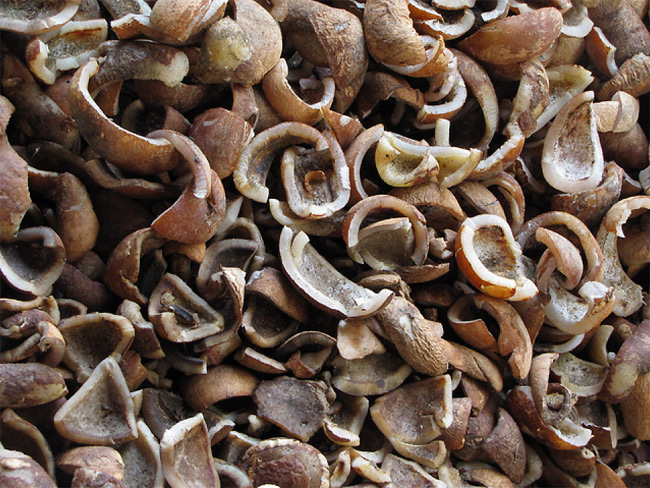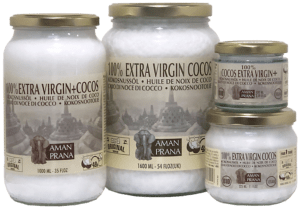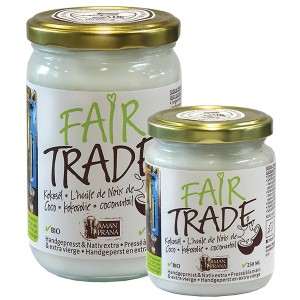How is coconut oil made and what is copra?
There are quite some stories going around about how they actually make coconut oil. Curious about how coconut oil is made or what copra is ? Read more below and learn more about copra and the production process. The first step of the coconut oil is of course the coconut. The quality of the latter and the way they are processed will obviously influence the class of coconut oil that results from it.
What is copra?
Copra is obtained by first removing the husk of the coconut, then break it in pieces and let the flesh dry. The drying of the copra is mostly done in the same area where the coconuts are cultivated. Copra is the dried flesh of coconuts. Every adult coconut palm bears 50-75 nuts that can be harvested, split with machetes and left to dry in the sun. The copra is then scraped out of the husk and gets to dry further on racks. Finally, it is packed in jute bags and transported to a processing facility.
Why it’s better to not use copra coconut oil?

Why should one avoid coconut oil of which the copra has been drying for too long? Very often, the drying flesh stays outdoors for too long. Most of the time, the sun-dried coconuts get contaminated by external influences. They go moldy because they haven’t been kept in a dry space and are exposed to the insects, vermin, birds and animals in the neighborhood.
Whenever coconut oil with bad copra is used, the coconut oil gets a brown haze. By decolorizing it, one gets the yellowish white color that is expected of coconut oil. In the process, the oil is substantially heated. By decolourization, the important nutrients, which is precisely the real benefit of the use of coconut oil, go to waste. This type of coconut oil is usually sold at low prices and is found in amongst others in Asian food shops. They hardly contain any nutritional value and are as such not always a valid or better choice than the ordinary baking fats. Should you choose to use deodorized coconut oil instead of extra virgin coconut oil, it is very important to have a look at the treatment process. Choose mechanically treated variants, definitely not chemically treated versions. These contain residues which you subsequently take in. Above all, avoid the variants where the copra has been lying out to dry for too long.
How is coconut oil made?
The origin of the coconut palm, the cocos nucifera, lies in South America. It can nowadays be found in several tropical regions, such as between the tropics and in coastal areas. The coconut palm can bloom several times a year, forming hundreds of male flowers, and sometimes but a few female flowers. Only after reaching the age of 12, the tree becomes commercially interesting. An adult tree can easily produce up to 100 fruits per year. 1 acre can sustain between 100-160 coconut palms. Once the fruits have ripened, the fibers are removed. These will be used in the manufacturing of for ropes, among other things. Then the nuts are halved and the flesh is removed. Next, the flesh is put in the sun for quite some time in order to dry. The copra is pressed into coconut oil. The coconut flesh actually consists of 60-70% of fat.
What does coconut oil?
When applying coconut oil to the skin, it has a soothing effect. Not just the skin will be happy with coconut oil; by using coconut oil in your dishes, you make a conscious choice. Although you may not like coconut, it can be worth trying out the coconut oil. It actually has but a very subtle flavor and scent. It cannot be compared to the flavor and scent of the original coconut, especially not when, for instance, you fry your vegetables in coconut oil. If you really dislike the scent and flavor of coconut oil, you can choose the deodorized variant of coconut oil. It is recommended however, to choose a coconut oil that has only been deodorized and not further refined. Always go for BIO and top quality coconut oil. Coconut oil is an oil that doesn’t dry out. It penetrates the skin. Coconut oil becomes liquid at about 25° C. Next to applying the coconut oil to your skin or using it in your dishes, coconut oil is also very suitable for mixing with for instance essential oils.
The Amanprana extra virgin coconut oil with fresher than fresh guarantee
The Amanprana coconut oil is different. We actually give you a fresher than fresh guarantee; there is a maximum 48 hour delay between peeling and pressing of the coconut. What does cold-pressed or extra virgin coconut oil mean? It means the oil has been mechanically pressed instead of chemically. In addition, only low temperatures are used, without the use of chemicals. Quite important because excessive temperatures can cause strong flavor differences and changes in nutritional value. Used as raw material When using copra as a basis for cold-pressed unrefined oil, it is not suitable for consumption. It needs to be further processed. The extra virgin quality is only possible when starting from fresh coconut flesh. Just like at Amanprana’s, where the 48 hour fresher than fresh guarantee is applied.
Amanprana coconut oil
Extra virgin+ coconut oil
 Read more about Extra virgin+ coconut oil
Read more about Extra virgin+ coconut oil
Fair Trade coconut oil
 Read more about Fair Trade coconut oil
Read more about Fair Trade coconut oil
